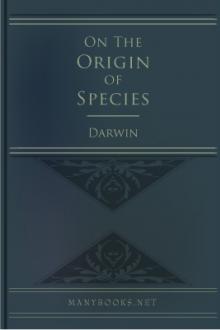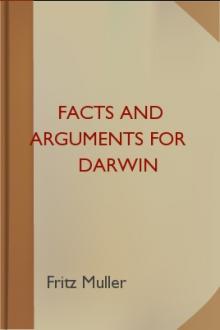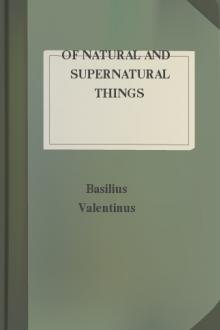The Origin of Species by means of Natural Selection (6th ed) by Charles Darwin (ebook reader below 3000 .TXT) 📕

- Author: Charles Darwin
- Performer: -
Book online «The Origin of Species by means of Natural Selection (6th ed) by Charles Darwin (ebook reader below 3000 .TXT) 📕». Author Charles Darwin
Fourthly, pigeons have been watched and tended with the utmost care, and loved by many people. They have been domesticated for thousands of years in several quarters of the world; the earliest known record of pigeons is in the fifth Aegyptian dynasty, about 3000 B.C., as was pointed out to me by Professor Lepsius; but Mr. Birch informs me that pigeons are given in a bill of fare in the previous dynasty. In the time of the Romans, as we hear from Pliny, immense prices were given for pigeons; “nay, they are come to this pass, that they can reckon up their pedigree and race.” Pigeons were much valued by Akber Khan in India, about the year 1600; never less than 20,000 pigeons were taken with the court. “The monarchs of Iran and Turan sent him some very rare birds;” and, continues the courtly historian, “His Majesty, by crossing the breeds, which method was never practised before, has improved them astonishingly.” About this same period the Dutch were as eager about pigeons as were the old Romans. The paramount importance of these considerations in explaining the immense amount of variation which pigeons have undergone, will likewise be obvious when we treat of selection. We shall then, also, see how it is that the several breeds so often have a somewhat monstrous character. It is also a most favourable circumstance for the production of distinct breeds, that male and female pigeons can be easily mated for life; and thus different breeds can be kept together in the same aviary.
I have discussed the probable origin of domestic pigeons at some, yet quite insufficient, length; because when I first kept pigeons and watched the several kinds, well knowing how truly they breed, I felt fully as much difficulty in believing that since they had been domesticated they had all proceeded from a common parent, as any naturalist could in coming to a similar conclusion in regard to the many species of finches, or other groups of birds, in nature. One circumstance has struck me much; namely, that nearly all the breeders of the various domestic animals and the cultivators of plants, with whom I have conversed, or whose treatises I have read, are firmly convinced that the several breeds to which each has attended, are descended from so many aboriginally distinct species. Ask, as I have asked, a celebrated raiser of Hereford cattle, whether his cattle might not have descended from Long-horns, or both from a common parent-stock, and he will laugh you to scorn. I have never met a pigeon, or poultry, or duck, or rabbit fancier, who was not fully convinced that each main breed was descended from a distinct species. Van Mons, in his treatise on pears and apples, shows how utterly he disbelieves that the several sorts, for instance a Ribston-pippin or Codlin-apple, could ever have proceeded from the seeds of the same tree. Innumerable other examples could be given. The explanation, I think, is simple: from long-continued study they are strongly impressed with the differences between the several races; and though they well know that each race varies slightly, for they win their prizes by selecting such slight differences, yet they ignore all general arguments, and refuse to sum up in their minds slight differences accumulated during many successive generations. May not those naturalists who, knowing far less of the laws of inheritance than does the breeder, and knowing no more than he does of the intermediate links in the long lines of descent, yet admit that many of our domestic races are descended from the same parents—may they not learn a lesson of caution, when they deride the idea of species in a state of nature being lineal descendants of other species?
PRINCIPLES OF SELECTION ANCIENTLY FOLLOWED, AND THEIR EFFECTS.
Let us now briefly consider the steps by which domestic races have been produced, either from one or from several allied species. Some effect may be attributed to the direct and definite action of the external conditions of life, and some to habit; but he would be a bold man who would account by such agencies for the differences between a dray and racehorse, a greyhound and bloodhound, a carrier and tumbler pigeon. One of the most remarkable features in our domesticated races is that we see in them adaptation, not indeed to the animal’s or plant’s own good, but to man’s use or fancy. Some variations useful to him have probably arisen suddenly, or by one step; many botanists, for instance, believe that the fuller’s teasel, with its hooks, which can not be rivalled by any mechanical contrivance, is only a variety of the wild Dipsacus; and this amount of change may have suddenly arisen in a seedling. So it has probably been with the turnspit dog; and this is known to have been the case with the ancon sheep. But when we compare the dray-horse and racehorse, the dromedary and camel, the various breeds of sheep fitted either for cultivated land or mountain pasture, with the wool of one breed good for one purpose, and that of another breed for another purpose; when we compare the many breeds of dogs, each good for man in different ways; when we compare the game-cock, so pertinacious in battle, with other breeds so little quarrelsome, with “everlasting layers” which never desire to sit, and with the bantam so small and elegant; when we compare the host of agricultural, culinary, orchard, and flower-garden races of plants, most useful to man at different seasons and for different purposes, or so beautiful in his eyes, we must, I think, look further than to mere variability. We can not suppose that all the breeds were suddenly produced as perfect and as useful as we now see them; indeed, in many cases, we know that this has not been their history. The key is man’s power of accumulative selection: nature gives successive variations; man adds them up in certain directions useful to him. In this sense he may be said to have made for himself useful breeds.
The great power of this principle of selection is not hypothetical. It is certain that several of our eminent breeders have, even within a single lifetime, modified to a large extent their breeds of cattle and sheep. In order fully to realise what they have done it is almost necessary to read several of the many treatises devoted to this subject, and to inspect the animals. Breeders habitually speak of an animal’s organisation as something plastic, which they can model almost as they please. If I had space I could quote numerous passages to this effect from highly competent authorities. Youatt, who was probably better acquainted with the works of agriculturalists than almost any other individual, and who was himself a very good judge of animals, speaks of the principle of selection as “that which enables the agriculturist, not only to modify the character of his flock, but to change it altogether. It is the magician’s wand, by means of which he may summon into life whatever form and mould he pleases.” Lord Somerville, speaking of what breeders have done for sheep, says: “It would seem as if they had chalked out upon a wall a form perfect in itself, and then had given it existence.” In Saxony the importance of the principle of selection in regard to merino sheep is so fully recognised, that men follow it as a trade: the sheep are placed on a table and are studied, like a picture by a connoisseur; this is done three times at intervals of months, and the sheep are each time marked and classed, so that the very best may ultimately be selected for breeding.
What English breeders have actually effected is proved by the enormous prices given for animals with a good pedigree; and these have been exported to almost every quarter of the world. The improvement is by no means generally due to crossing different breeds; all the best breeders are strongly opposed to this practice, except sometimes among closely allied sub-breeds. And when a cross has been made, the closest selection is far more indispensable even than in ordinary cases. If selection consisted merely in separating some very distinct variety and breeding from it, the principle would be so obvious as hardly to be worth notice; but its importance consists in the great effect produced by the accumulation in one direction, during successive generations, of differences absolutely inappreciable by an uneducated eye—differences which I for one have vainly attempted to appreciate. Not one man in a thousand has accuracy of eye and judgment sufficient to become an eminent breeder. If gifted with these qualities, and he studies his subject for years, and devotes his lifetime to it with indomitable perseverance, he will succeed, and may make great improvements; if he wants any of these qualities, he will assuredly fail.
Few would readily believe in the natural capacity and years of practice requisite to become even a skilful pigeon-fancier.
The same principles are followed by horticulturists; but the variations are here often more abrupt. No one supposes that our choicest productions have been produced by a single variation from the aboriginal stock. We have proofs that this is not so in several cases in which exact records have been kept; thus, to give a very trifling instance, the steadily increasing size of the common gooseberry may be quoted. We see an astonishing improvement in many florists’ flowers, when the flowers of the present day are compared with drawings made only twenty or thirty years ago. When a race of plants is once pretty well established, the seed-raisers do not pick out the best plants, but merely go over their seed-beds, and pull up the “rogues,” as they call the plants that deviate from the proper standard. With animals this kind of selection is, in fact, likewise followed; for hardly any one is so careless as to breed from his worst animals.
In regard to plants, there is another means of observing the accumulated effects of selection—namely, by comparing the diversity of flowers in the different varieties of the same species in the flower-garden; the diversity of leaves, pods, or tubers, or whatever part is valued, in the kitchen-garden, in comparison with the flowers of the same varieties; and the diversity of fruit of the same species in the orchard, in comparison with the leaves and flowers of the same set of varieties. See how different the leaves of the cabbage are, and how extremely alike the flowers; how unlike the flowers of the heartsease are, and how alike the leaves; how much the fruit of the different kinds of gooseberries differ in size, colour, shape, and hairiness, and yet the flowers present very slight differences. It is not that the varieties which differ largely in some one point do not differ at all in other points; this is hardly ever—I speak after careful observation—perhaps never, the case. The law of correlated variation, the importance of which should never be overlooked, will ensure some differences; but, as a general rule, it cannot be doubted that the continued selection of slight variations, either in the leaves, the flowers, or the fruit, will produce races differing from each other chiefly in these characters.
It may be objected that the principle of selection has been reduced to methodical practice for scarcely more than three-quarters of a century; it has certainly





Comments (0)